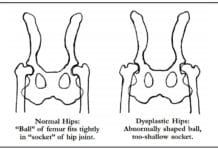Boost Your Dog’s Digestive System
Ask the average dog owner about fasting her dog and you may see her blanche at the very idea of making Skippy miss a meal. In a culture that is obsessed with food, it is easy to understand a conscientious dog owner’s reluctance to deliberately withhold sustenance. Yet many dog owners routinely do just that. We interviewed a number of dog owners who utilize fasting protocols in their feeding regimens. Some had more than 10 years of experience with periodic fasts, and some had started recently fasting their dogs only recently. Often, the fasting was used in conjunction with a natural diet.
Building Your Dogs Immune Health
Canine immune system disorders range from very common (such as seasonal allergies), to extremely rare disorders that afflict certain breeds (and even, in some cases, certain branches of individual breeds). Someday, the Canine Genome Project may well bring life-saving illumination to the process by which specific genes trigger specific diseases. At present, however, the inheritance of effective immunity continues to be a mysterious, if not star-crossed, commodity. Some dogs, like some people, are unlucky. However, the immunity that any individual dog is born with can often be improved with enlightened canine husbandry practices, traditional medical care, and complementary care from holistic health modalities.
Helping Dogs With Hip Dysplasia
First, I need to make it clear that there are many types of rear end lamenesses that may end up being diagnosed as hip dysplasia, but you really can't accept the diagnosis of hip dysplasia without hip x-rays. Hip dysplasia is a radiographic diagnosis, not a clinical diagnosis. That may be splitting hairs, but I see many dogs with conditions such as ruptured and improperly healed cruciate ligaments or lower back arthritis that have been diagnosed with hip dysplasia. Only radiographs can determine whether or not a dog has hip dysplasia.
Stretching Your Dog Reduces the Chance of Muscle Tears
All dogs instinctively know how to stretch and do so with great enjoyment. Dogs stretch without fail upon awakening and whenever the mood strikes during the rest of the day. Who hasn’t watched a dog inch his front paws out in front of him as far as possible leaning into the stretch until it literally ripples along the length of his trunk? When the stretch finally reaches the hips, the hind legs are extended far behind the body in what appears to be total ecstasy. The dog completes the routine by dropping to his elbows and stretching the back in a doggy bow that temporarily elevates the rump. Then, the hindquarters flop to the floor in a grand finale to the stretch.
Canine Skin Allergies and Skin Care
Quick: What’s the number one canine disease complaint heard by veterinarians? That’s right, it’s itching and scratching. “My dog is ripping himself to shreds!” “She’s almost bald from chewing herself!” “He’s rubbing himself on the carpet, the furniture, and even the walls!” Many people seem to think that all dogs scratch themselves. Of course, pretty much every dog will scratch for a moment if they get a little itch, but that’s not what we’re discussing. The scratching we’re discussing – the scratching that is of real concern – is not occasional or casual.
Hard Work, Huge Rewards
"I just set eyes on Gracie and I knew." That’s how Mary Ellen Grimaldi describes first seeing the approximately two-year-old Beagle-Shepherd mix at the New York state animal shelter. Not surprisingly, her first impressions held true. “She has been an absolutely wonderful dog,” says Grimaldi. Wonderful, but allergic. Gracie, a mid-size dog with a smooth, short coat, soon began showing signs of allergies. “She was licking her feet constantly, rubbing her face, rolling, generally itchy,” says Grimaldi. “And I didn’t know that licking feet was the typical manifestation of allergies.”
Pharmaceuticals for Dogs: There Is No Magic Pill
Pet pills are big business, raking in an estimated $3 billion last year and growing by 20 percent each year. Pharmaceutical companies have found they can modify human drugs for pets without much additional research expense. The Food and Drug Administration (FDA) has approved 15 new behavior-altering drugs for veterinary use in the last year and a half. The two new canine drugs receiving the biggest ad blitz and the most mainstream media coverage, Clomicalm and Anipryl, both were adapted from human drugs.
The Canine Autoimmune System
Previously in Whole Dog Journal, we discussed the dog's complex immune system. We described what body parts and functions actually comprise the dog's system of immunity" and explained how this system acts to protect the dog from foreign agents including viruses
Enzyme Therapy for Quicker Canine Injury Recovery
Enzymes are protein-like compounds that, in small amounts, speed the rate of biological reactions. Unstable, fragile, and easily inactivated, enzymes are produced within living cells to perform specific biochemical reactions. Enzymes exist in plants as well as animals. Without them, life as we know it would not exist. Enzymes cause seeds to sprout, flowers to blossom, plants to grow, autumn leaves to change color, and fruits to ripen.
Canine Diabetes, A Common Yet Serious Problem
Diabetes is a common and serious problem in pets. Formally known as diabetes mellitus (the sweet sickness), it’s a disorder of the pancreas gland. The pancreas produces a hormone called insulin, whose purpose is to drive nutrients, specifically glucose, or blood sugar, into the cells. It’s the body’s most important fuel molecule. Good management is the key to longevity for diabetic dogs.
Holistic Treatments for Canine Skin Rashes
Juniper suffered a brush with bloat















